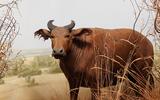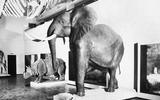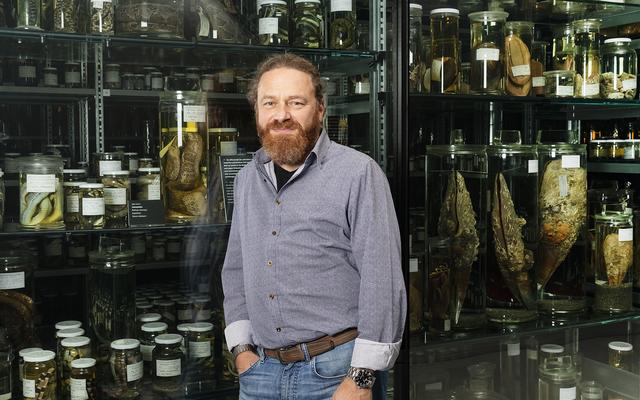Why is a natural history museum involved with provenance research? The location, date of death and donors of the animals are known, otherwise they would be of no scientific value. But behind the specimens, bones, minerals and fossils there are also interesting stories that go beyond simple data and are revealed through provenance research. Who procured the animals for the museum? What motivated these actors, and who commissioned them? What did they experience on their journeys and with whom did they come into contact? The search for answers leads back into colonial history, among other things.
In the case of NMBE, a large proportion of the “Animals of Africa” originate from the former British-occupied territories of East Africa, namely Kenya and Uganda. The big game hunter Vivienne von Wattenwyl and her father Bernard von Wattenwyl killed the animals on a hunting trip between 1923 and 1924 and had the skins and bones transported to Bern. The two benefited from colonial structures, that is, from the exploitation of the knowledge and labor of the local population.

Intensive research was also carried out into the history of the exhibited Angolan red buffalo cow (see picture above), which found its way to Bern in 1955 via the big game hunter Joseph Fénykövi. As provenance researcher Sarah Csernay was able to find out thanks to documents from the museum's own archive, as well as other sources, this animal was not only shot for purely scientific reasons, but a blend of a desire for prestige, ambition, colonial behavior and European fantasies of superiority also played a major role. As early as the 1950s, there was public criticism that some of the big game hunting by Fénykövi was carried out using methods that were in stark contrast to the museum’s scientifically-based claims, as they did not comply with hunting practices or animal welfare. Sarah Csernay’s corresponding article entitled “Im Visier der Wissenschaft” (In Science's Crosshairs) was published in 2024 (see below).
In 2022, with the help of an international group of experts, our exhibition team presented the 38 historical dioramas “Animals of Africa’ in a colonial context as part of a small exhibition in the entrance area. Since then, the controversial history and the Eurocentric view of the African continent have been addressed. The inscriptions on the display cases no longer convey only minimal information such as German and Latin names and endangered status of an animal, but also additional useful information about its way of life, species loss and habitat destruction – and the animal names in the respective official language of the area of origin. All images and terms used in the exhibition were critically examined and contextualized where necessary.
As part of the overall project “Diorama – History, Idyll, Illusion,” the team revised the content of all 210 historical dioramas in the museum, including the “Animals of Switzerland,” “Animals of the North” and “Animals of Asia”. All these steps are individual pieces of a larger puzzle. We take our task of making the history of the origins of our collections visible, piece by piece, very seriously.
Csernay, Sarah: «Im Visier der Wissenschaft. Jagen am Ende der Welt», in K. Lee Chichester, Priska Gisler, Kunstmuseum Bern (Hrsg.): «Koloniale Tiere? Tierbilder im Kontext des Kolonialismus», Neofelis, Berlin, 2024, S. 305-327.
Csernay, Sarah und Hertwig, Stefan: «Kontextualisierung zoologischer Sammlungen», in: Verband der Museen der Schweiz (Hrsg.): «Provenienzforschung im Museum II. Sammlungen aus kolonialen Kontexten. Grundlagen und Einführung in die Praxis», VMS, Zürich, 2022, online.
Strahm, Dora und Christ, Stefanie: «Zwischen Idyll und Lebensraumzerstörung: neuer Blick auf Afrika-Dioramen», in: Medaillon. Informationen aus der Burgergemeinde Bern, Nr. 38, November 2022, S. 8-9, online.
Gisler, Priska: «Man hat uns für das Wenden der Ohren einen nützlichen Wink gegeben. Zur kolonialen Geschichte des Elefantenpräparats im Naturhistorischen Museum Bern», in K. Lee Chichester, Priska Gisler, Kunstmuseum Bern (Hrsg.): «Koloniale Tiere? Tierbilder im Kontext des Kolonialismus», Neofelis, Berlin, 2024, S. 279-304.
Naturhistorisches Museum Bern (Hrsg.): Podcast-Beitrag «Grosswildjagd und Kolonialgeschichte: Welche Rolle spiel(t)en wir?», mit Gesine Krüger, Historikerin Universität Zürich, Solomon Sebuliba, Umweltbiologe Universität Oldenburg, Antoine Spillmann, Safari Club International, Stefan Hertwig, Leiter Wirbeltiere NMBE, 2022, online.
Schindler, Sara: «Auf Safari. Was ein Tierpräparat über die Geschichte der Jagdreisen in Afrika erzählt». Publiziert auf: Geschichteimpuls.ch, März 2025, online.
Are you a researcher, involved in provenance research in the context of natural history and have a question about our specimens, collections or archives? Or would you like to draw our attention to your own publication on the subject? Then we look forward to hearing from you.




